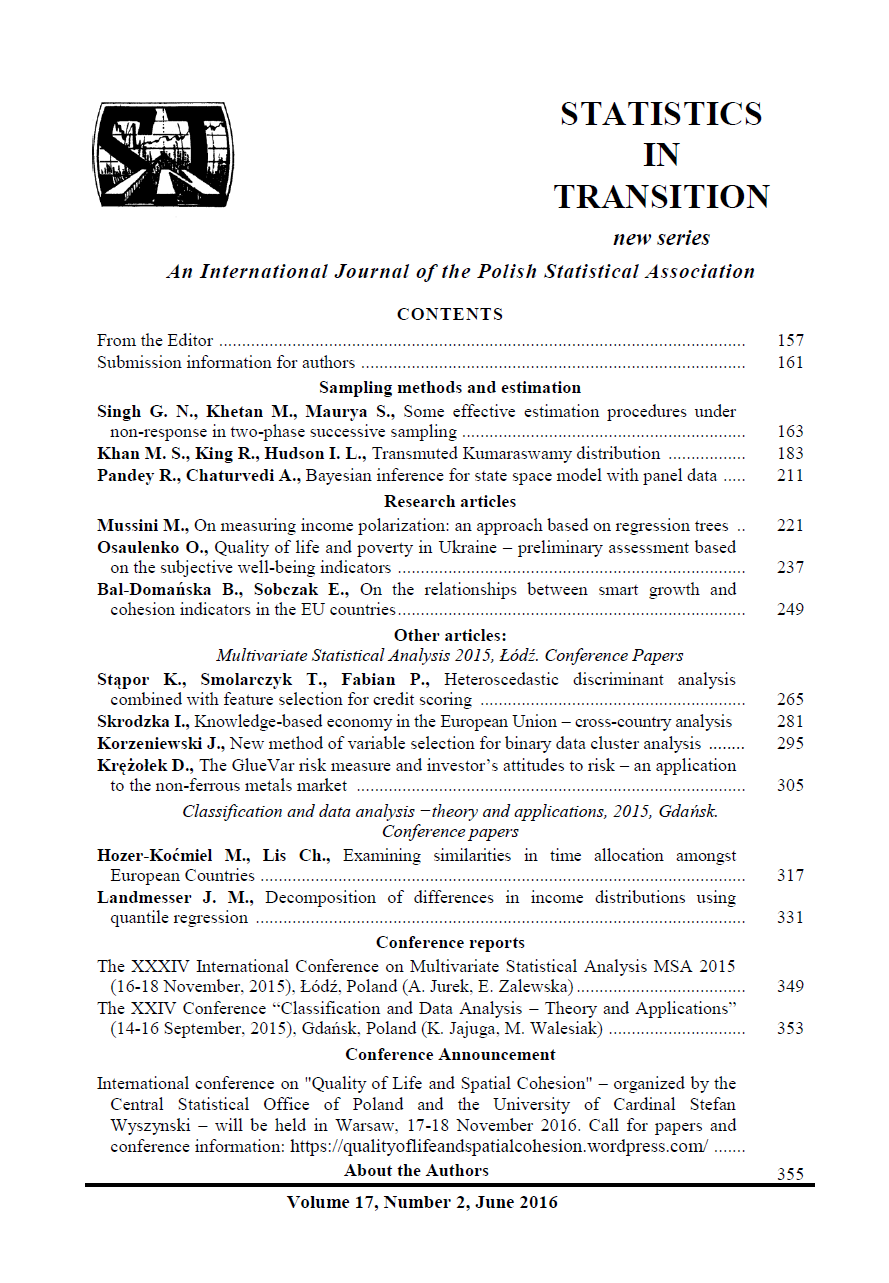ARTICLE
ABSTRACT
Within the framework of the Europe 2020 strategy smart growth is listed as one of the leading policy objectives aimed at improving the situation in education, digital society and research and innovation. The objective of this article is to evaluate the relationships between smart growth and economic and social cohesion factors. Aggregate measures were used to describe smart growth pillars. Here, social cohesion is described by the level of employment rate as one of the conditions essential to the well-being and prosperity of individuals. Economic cohesion is defined by the level of GDP per capita in PPS. Observation of these three phenomena forms the basis for the construction of panel data models and undertaking the assessment of the relationships between smart growth and economic and social cohesion factors. The study was performed on the group of 27 European Union countries in the period of 2002-2011.
KEYWORDS
economic and social cohesion, smart growth, European Union countries, panel data analysis
REFERENCES
A strategy for smart, sustainable and inclusive growth, (2010). European Commission. Communication from the Commission EUROPE 2020,Brussels, 3.3.2010.
ARELLANO, M., (2003). Panel Data Econometrics, Oxford: Oxford University Press 2003.
BERGER-SCHMITT, R., (2000). Social cohesion as an aspect of the quality of societies: concept and measurement. Centre for Survey Research and Methodology Mannheim, EuReporting Working Paper, No. 14/2000.
CICHY, K., (2008). Kapitał ludzki i postęp techniczny jako determinanty wzrostu gospodarczego [Human capital and technological progress as the determinants of economic growth], Instytut Wiedzy i Innowacji, Warszawa.
DOMINIAK, J., CHURSKI, P., (2012). Rola innowacji w kształtowaniu regionów wzrostu i stagnacji w Polsce [The role of innovation in shaping the regions of growth and stagnation in Poland], Studia Regionalne i Lokalne,No.4(50)/2012, pp. 54–77.
FIEDOR, B., (2010). Pomoc zewnętrzna i endogenizacja wzrostu a polityka spójności – ze szczególnym uwzględnieniem Unii Europejskiej, Kilka refleksji [External aid and endogenisation of growth, and cohesion policy -with focus on the European Union, Some reflections] [in:] M. Klamut. E. Szostak. Spójność w rozwoju regionalnym w Polsce obecnie i w przyszłości [Cohesion in regional development in Poland at present and in the future],Wrocław University of Economics Publishing House. Wrocław, pp. 11–23.
GORYNIA, M., JANKOWSKA, B., (2008). Klastry a międzynarodowa konkurencyjność i internacjonalizacja przedsiębiorstw [Clusters and international competitiveness and internationalization of enterprises],Centrum Doradztwa I Informacji. Difin, Warszawa.
GREENE, W. H., (2003). Econometric analysis. Pearson Education International. New Jersey.
HELLWIG, Z., (1968). Zastosowanie metody taksonomicznej do typologicznego podziału krajów ze względu na poziom ich rozwoju oraz zasoby i strukturę wykwalifikowanych kadr [The application of taxonomic method for typological division of countries regarding their development level as well as the resources and structure of qualified personnel]. "Przegląd Statystyczny" [“Statistical Review”] 1968 Bulletin, No. 4, pp. 307–327.
HERBST, M., edit., (2007). Kapitał ludzki i kapitał społeczny a rozwój regionalny [Human capital and social capital vs. regional development],SCHOLAR, Warsaw.
MARKOWSKA, M., STRAHL, D., (2013). Multicriteria European regional space classification regarding economic and social cohesion and smart growth level [Klasyfikacja wielokryterialna europejskiej przestrzeni regionalnej uwzględniająca spójność ekonomiczną i społeczną oraz rozwój inteligentny],The 7th Professor A. Zelias International Conference on Modelling and Forecasting of Socio-Economic Phenomena May 7-10, Zakopane.
MARSHALL, A., (1925). Zasady ekonomiki [Principles of Economics], Warsaw, M. Arct, polski przekład publikacji z roku 1890 [Polish translation of the publication from 1890].
KAWA, P., (2007). Rola wiedzy i innowacji w stymulowaniu wzrostu gospodarczego [The role of knowledge and innovation in stimulating economic growth], [in:] K. Piech. E. Skrzypek (eds) „Wiedza w gospodarce. społeczeństwie i przedsiębiorstwach: pomiary, charakterystyka, zarządzanie” ["Knowledge in the economy, society and enterprises: measurement, characteristics, management], Instytut Wiedzy i Innowacji, Warszawa,pp. 16–29.
OECD, (2011). Perspectives on Global Development 2012: Social Cohesion in a Shifting World. OECD Publishing. Paris 2011, DOI: http://dx.doi.org/10.1787/persp_glob_dev-2012-en
PORTER, M. E., (1990). The Competitive Advantage of Nations. Harvard Business Review.
ROMER, P., (1990). Endogenous technological change“, Journal of political Economy”, No 5, pp. 71–102.
ROMER, P., (1986). Increasing returns and long-run growth, “Journal of political Economy”, October 1986, pp. 1002–1037.
STANLEY, D., (2003). What Do We Know about Social Cohesion: The Research Perspective of the Federal Government's Social Cohesion Research Network. The Canadian Journal of Sociology/Cahiers canadiens de sociologie, Vol. 28, No. 1, Special Issue on Social Cohesion in Canada (Winter 2003),pp. 5–17.
STRAHL, D., (2010). Innowacyjność europejskiej przestrzeni regionalnej a dynamika rozwoju gospodarczego [Innovation in the European regional area and the dynamics of economic development], Uniwersytet Ekonomiczny,Wrocław.
WALESIAK, M., (2006). Uogólniona miara odległości w statystycznej analizie wielowymiarowej [Generalised distance measure in statistical multivariate analysis], Wrocław University of Economics Publishing House, Wrocław.
WOOLDRIDGE, J. M., (2002). Econometric analyses of cross section and panel data, Massachusetts Institute of Technology.
